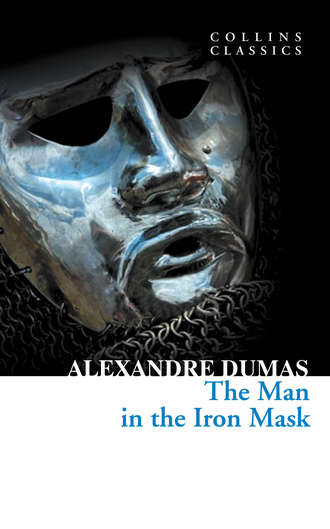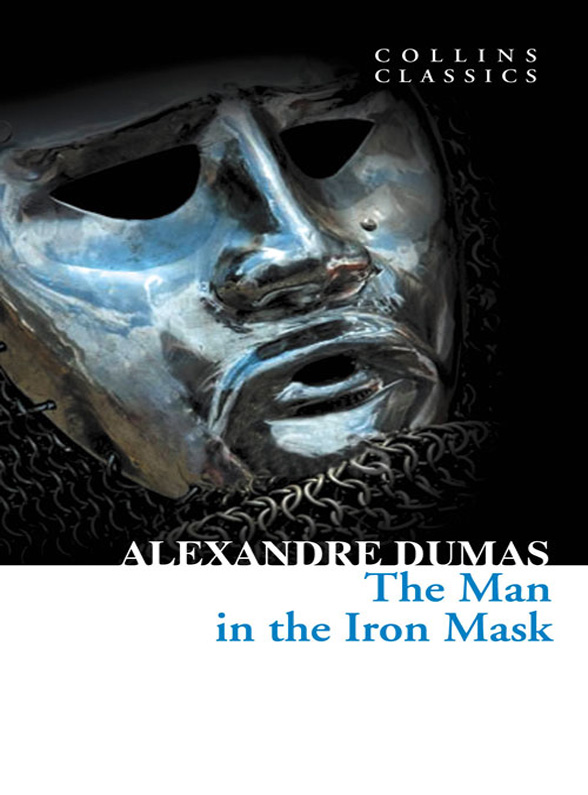
Полная версия
The Man in the Iron Mask


THE MAN IN THE IRON MASK
Alexandre Dumas

CONTENTS
Cover
Title Page
Introduction
Chapter 1 The Prisoner.
Chapter 2 How Mouston Had Become Fatter without Giving Porthos Notice Thereof, and of the Troubles Which Consequently Befell that Worthy Gentleman.
Chapter 3 Who Messire Jean Percerin Was.
Chapter 4 The Patterns.
Chapter 5 Where, Probably, Moliere Obtained His First Idea of the Bourgeois Gentilhomme.
Chapter 6 The Bee-Hive, the Bees, and the Honey.
Chapter 7 Another Supper at the Bastille.
Chapter 8 The General of the Order.
Chapter 9 The Tempter.
Chapter 10 Crown and Tiara.
Chapter 11 The Chateau de Vaux-le-Vicomte.
Chapter 12 The Wine of Melun.
Chapter 13 Nectar and Ambrosia.
Chapter 14 A Gascon, and a Gascon and a Half.
Chapter 15 Colbert.
Chapter 16 Jealousy.
Chapter 17 High Treason.
Chapter 18 A Night at the Bastille.
Chapter 19 The Shadow of M. Fouquet.
Chapter 20 The Morning.
Chapter 21 The King’s Friend.
Chapter 22 Showing How the Countersign Was Respected at the Bastille.
Chapter 23 The King’s Gratitude.
Chapter 24 The False King.
Chapter 25 In Which Porthos Thinks He Is Pursuing a Duchy.
Chapter 26 The Last Adieux.
Chapter 27 Monsieur de Beaufort.
Chapter 28 Preparations for Departure.
Chapter 29 Planchet’s Inventory.
Chapter 30 The Inventory of M. de Beaufort.
Chapter 31 The Silver Dish.
Chapter 32 Captive and Jailers.
Chapter 33 Promises.
Chapter 34 Among Women.
Chapter 35 The Last Supper.
Chapter 36 In M. Colbert’s Carriage.
Chapter 37 The Two Lighters.
Chapter 38 Friendly Advice.
Chapter 39 How the King, Louis XIV., Played His Little Part.
Chapter 40 The White Horse and the Black.
Chapter 41 In Which the Squirrel Falls,—the Adder Flies.
Chapter 42 Belle-Ile-en-Mer.
Chapter 43 Explanations by Aramis.
Chapter 44 Result of the Ideas of the King, and the Ideas of D’Artagnan.
Chapter 45 The Ancestors of Porthos.
Chapter 46 The Son of Biscarrat.
Chapter 47 The Grotto of Locmaria.
Chapter 48 The Grotto.
Chapter 49 An Homeric Song.
Chapter 50 The Death of a Titan.
Chapter 51 Porthos’s Epitaph.
Chapter 52 M. de Gesvres’s Round.
Chapter 53 King Louis XIV.
Chapter 54 M. Fouquet’s Friends.
Chapter 55 Porthos’s Will.
Chapter 56 The Old Age of Athos.
Chapter 57 Athos’s Vision.
Chapter 58 The Angel of Death.
Chapter 59 The Bulletin.
Chapter 60 The Last Canto of the Poem.
Epilogue
Classic Literature: Words and Phrases Adapted from the collins english dictionary
About the Author
History of Collins
Copyright
About the Publisher
INTRODUCTION
In the months of March—July in 1844, in the magazine Le Siecle, the first portion of a story appeared, penned by the celebrated playwright Alexandre Dumas. It was based, he claimed, on some manuscripts he had found a year earlier in the Bibliotheque Nationale while researching a history he planned to write on Louis XIV. They chronicled the adventures of a young man named D’Artagnan who, upon entering Paris, became almost immediately embroiled in court intrigues, international politics, and ill-fated affairs between royal lovers. Over the next six years, readers would enjoy the adventures of this youth and his three famous friends, Porthos, Athos, and Aramis, as their exploits unraveled behind the scenes of some of the most momentous events in French and even English history.
Eventually these serialized adventures were published in novel form, and became the three D’Artagnan Romances known today. Here is a brief summary of the first two novels:
The Three Musketeers (serialized March—July, 1844): The year is 1625. The young D’Artagnan arrives in Paris at the tender age of 18, and almost immediately offends three musketeers, Porthos, Aramis, and Athos. Instead of dueling, the four are attacked by five of the Cardinal’s guards, and the courage of the youth is made apparent during the battle. The four become fast friends, and, when asked by D’Artagnan’s landlord to find his missing wife, embark upon an adventure that takes them across both France and England in order to thwart the plans of the Cardinal Richelieu. Along the way, they encounter a beautiful young spy, named simply Milady, who will stop at nothing to disgrace Queen Anne of Austria before her husband, Louis XIII, and take her revenge upon the four friends.
Twenty Years After (serialized January—August, 1845): The year is now 1648, twenty years since the close of the last story. Louis XIII has died, as has Cardinal Richelieu, and while the crown of France may sit upon the head of Anne of Austria as Regent for the young Louis XIV, the real power resides with the Cardinal Mazarin, her secret husband. D’Artagnan is now a lieutenant of musketeers, and his three friends have retired to private life. Athos turned out to be a nobleman, the Comte de la Fere, and has retired to his home with his son, Raoul de Bragelonne. Aramis, whose real name is D’Herblay, has followed his intention of shedding the musketeer’s cassock for the priest’s robes, and Porthos has married a wealthy woman, who left him her fortune upon her death. But trouble is stirring in both France and England. Cromwell menaces the institution of royalty itself while marching against Charles I, and at home the Fronde is threatening to tear France apart. D’Artagnan brings his friends out of retirement to save the threatened English monarch, but Mordaunt, the son of Milady, who seeks to avenge his mother’s death at the musketeers’ hands, thwarts their valiant efforts. Undaunted, our heroes return to France just in time to help save the young Louis XIV, quiet the Fronde, and tweak the nose of Cardinal Mazarin.
The third novel, The Vicomte de Bragelonne (serialized October, 1847—January, 1850), has enjoyed a strange history in its English translation. It has been split into three, four, or five volumes at various points in its history. The five-volume edition generally does not give titles to the smaller portions, but the others do.
The Vicomte de Bragelonne: It is the year 1660, and D’Artagnan, after thirty-five years of loyal service, has become disgusted with serving King Louis XIV while the real power resides with the Cardinal Mazarin, and has tendered his resignation. He embarks on his own project, that of restoring Charles II to the throne of England, and, with the help of Athos, succeeds, earning himself quite a fortune in the process. D’Artagnan returns to Paris to live the life of a rich citizen, and Athos, after negotiating the marriage of Philip, the king’s brother, to Princess Henrietta of England, likewise retires to his own estate, La Fere. Meanwhile, Mazarin has finally died, and left Louis to assume the reigns of power, with the assistance of M. Colbert, formerly Mazarin’s trusted clerk. Colbert has an intense hatred for M. Fouquet, the king’s superintendent of finances, and has resolved to use any means necessary to bring about his fall. With the new rank of intendant bestowed on him by Louis, Colbert succeeds in having two of Fouquet’s loyal friends tried and executed. He then brings to the king’s attention that Fouquet is fortifying the island of Belle-Ile-en-Mer, and could possibly be planning to use it as a base for some military operation against the king. Louis calls D’Artagnan out of retirement and sends him to investigate the island, promising him a tremendous salary and his long-promised promotion to captain of the musketeers upon his return. At Belle-Isle, D’Artagnan discovers that the engineer of the fortifications is, in fact, Porthos, now the Baron du Vallon, and that’s not all. The blueprints for the island, although in Porthos’s handwriting, show evidence of another script that has been erased, that of Aramis. D’Artagnan later discovers that Aramis has become the bishop of Vannes, which is, coincidentally, a parish belonging to M. Fouquet. Suspecting that D’Artagnan has arrived on the king’s behalf to investigate, Aramis tricks D’Artagnan into wandering around Vannes in search of Porthos, and sends Porthos on an heroic ride back to Paris to warn Fouquet of the danger. Fouquet rushes to the king, and gives him Belle-Isle as a present, thus allaying any suspicion, and at the same time humiliating Colbert, just minutes before the usher announces someone else seeking an audience with the king.
Ten Years Later: As 1661 approaches, Princess Henrietta of England arrives for her marriage, and throws the court of France into complete disorder. The jealousy of the Duke of Buckingham, who is in love with her, nearly occasions a war on the streets of Le Havre, thankfully prevented by Raoul’s timely and tactful intervention. After the marriage, though, Monsieur Philip becomes horribly jealous of Buckingham, and has him exiled. Before leaving, however, the duke fights a duel with M. de Wardes at Calais. De Wardes is a malicious and spiteful man, the sworn enemy of D’Artagnan, and, by the same token, that of Athos, Aramis, Porthos, and Raoul as well. Both men are seriously wounded, and the duke is taken back to England to recover. Raoul’s friend, the Comte de Guiche, is the next to succumb to Henrietta’s charms, and Monsieur obtains his exile as well, though De Guiche soon effects a reconciliation. But then the king’s eye falls on Madame Henrietta during the comte’s absence, and this time Monsieur’s jealousy has no recourse. Anne of Austria intervenes, and the king and his sister-in-law decide to pick a young lady with whom the king can pretend to be in love, the better to mask their own affair. They unfortunately select Louise de la Valliere, Raoul’s fiancee. While the court is in residence at Fontainebleau, the king unwittingly overhears Louise confessing her love for him while chatting with her friends beneath the royal oak, and the king promptly forgets his affection for Madame. That same night, Henrietta overhears, at the same oak, De Guiche confessing his love for her to Raoul. The two embark on their own affair. A few days later, during a rainstorm, Louis and Louise are trapped alone together, and the whole court begins to talk of the scandal while their love affair blossoms. Aware of Louise’s attachment, the king arranges for Raoul to be sent to England for an indefinite period.
Meanwhile, the struggle for power continues between Fouquet and Colbert. Although the Belle-Isle plot backfired, Colbert prompts the king to ask Fouquet for more and more money, and without his two friends to raise it for him, Fouquet is sorely pressed. The situation gets so bad that his new mistress, Madame de Belliere, must resort to selling all her jewels and her gold and silver plate. Aramis, while this is going on, has grown friendly with the governor of the Bastille, M. de Baisemeaux, a fact that Baisemeaux unwittingly reveals to D’Artagnan while inquiring of him as to Aramis’s whereabouts. This further arouses the suspicions of the musketeer, who was made to look ridiculous by Aramis. He had ridden overnight at an insane pace, but arrived a few minutes after Fouquet had already presented Belle-Isle to the king. Aramis learns from the governor the location of a mysterious prisoner, who bears a remarkable resemblance to Louis XIV—in fact, the two are identical. He uses the existence of this secret to persuade a dying Franciscan monk, the general of the society of the Jesuits, to name him, Aramis, the new general of the order. On Aramis’s advice, hoping to use Louise’s influence with the king to counteract Colbert’s influence, Fouquet also writes a love letter to La Valliere, unfortunately undated. It never reaches its destination, however, as the servant ordered to deliver it turns out to be an agent of Colbert’s.
Louise de la Valliere: Believing D’Artagnan occupied at Fontainebleau and Porthos safely tucked away at Paris, Aramis holds a funeral for the dead Franciscan—but in fact, Aramis is wrong in both suppositions. D’Artagnan has left Fontainebleau, bored to tears by the fetes, retrieved Porthos, and is visiting the country-house of Planchet, his old lackey. This house happens to be right next door to the graveyard, and upon observing Aramis at this funeral, and his subsequent meeting with a mysterious hooded lady, D’Artagnan, suspicions aroused, resolves to make a little trouble for the bishop. He presents Porthos to the king at the same time as Fouquet presents Aramis, thereby surprising the wily prelate. Aramis’s professions of affection and innocence do only a little to allay D’Artagnan’s concerns, and he continues to regard Aramis’s actions with a curious and wary eye. Meanwhile, much to his delight, Porthos is invited to dine with the king as a result of his presentation, and with D’Artagnan’s guidance, manages to behave in such a manner as to procure the king’s marked favor.
The mysterious woman turns out to be the Duchesse de Chevreuse, a notorious schemer and former friend of Anne of Austria. She comes bearing more bad news for Fouquet, who is already in trouble, as the king has invited himself to a fete at Vaux, Fouquet’s magnificent mansion, that will surely bankrupt the poor superintendent. The Duchesse has letters from Mazarin that prove that Fouquet has received thirteen million francs from the royal coffers, and she wishes to sell these letters to Aramis. Aramis refuses, and the letters are instead sold to Colbert. Fouquet, meanwhile, discovers that the receipt that proves his innocence in the affair has been stolen from him. Even worse, Fouquet, desperate for money, is forced to sell the parliamentary position that renders him untouchable by any court proceedings. As part of her deal with Colbert, though, Chevreuse also obtains a secret audience with the queen-mother, where the two discuss a shocking secret—Louis XIV has a twin brother, long believed, however, to be dead.
Meanwhile, in other quarters, De Wardes, Raoul’s inveterate enemy, has returned from Calais, barely recovered from his wounds, and no sooner does he return than he begins again to insult people, particularly La Valliere, and this time the comte de Guiche is the one to challenge him. The duel leaves De Guiche horribly wounded, but enables Madame to use her influence to destroy De Wardes’s standing at court. The fetes, however, come to an end, and the court returns to Paris. The king has been more than obvious about his affections for Louise, and Madame, the queen-mother, and the queen join forces to destroy her. She is dishonorably discharged from court, and in despair, she flees to the convent at Chaillot. Along the way, though, she runs into D’Artagnan, who manages to get word back to the king of what has taken place. By literally begging Madame in tears, Louis manages to secure Louise’s return to court—but Madame still places every obstacle possible before the lovers. They have to resort to building a secret staircase and meeting in the apartments of M. de Saint-Aignan, where Louis has a painter create a portrait of Louise. But Madame recalls Raoul from London and shows him these proofs of Louise’s infidelity. Raoul, crushed, challenges Saint-Aignan to a duel, which the king prevents, and Athos, furious, breaks his sword before the king. The king has D’Artagnan arrest Athos, and at the Bastille they encounter Aramis, who is paying Baisemeaux another visit. Raoul learns of Athos’s arrest, and with Porthos in tow, they effect a daring rescue, surprising the carriage containing D’Artagnan and Athos as they leave the Bastille. Although quite impressive, the intrepid raid is in vain, as D’Artagnan has already secured Athos’s pardon from the king. Instead, everybody switches modes of transport; D’Artagnan and Porthos take the horses back to Paris, and Athos and Raoul take the carriage back to La Fere, where they intend to reside permanently, as the king is now their sworn enemy, Raoul cannot bear to see Louise, and they have no more dealings in Paris.
Aramis, left alone with Baisemeaux, inquires the governor of the prison about his loyalties, in particular to the Jesuits. The bishop reveals that he is a confessor of the society, and invokes their regulations in order to obtain access to this mysterious prisoner who bears such a striking resemblance to Louis XIV …
And so Baisemeaux is conducting Aramis to the prisoner as the final section of The Vicomte de Bragelonne and this final story of the D’Artagnan Romances opens.
John Bursey
CHAPTER 1 The Prisoner.
Since Aramis’s singular transformation into a confessor of the order, Baisemeaux was no longer the same man. Up to that period, the place which Aramis had held in the worthy governor’s estimation was that of a prelate whom he respected and a friend to whom he owed a debt of gratitude; but now he felt himself an inferior, and that Aramis was his master. He himself lighted a lantern, summoned a turnkey, and said, returning to Aramis, “I am at your orders, monseigneur.” Aramis merely nodded his head, as much as to say, “Very good”; and signed to him with his hand to lead the way. Baisemeaux advanced, and Aramis followed him. It was a calm and lovely starlit night; the steps of three men resounded on the flags of the terraces, and the clinking of the keys hanging from the jailer’s girdle made itself heard up to the stories of the towers, as if to remind the prisoners that the liberty of earth was a luxury beyond their reach. It might have been said that the alteration effected in Baisemeaux extended even to the prisoners. The turnkey, the same who, on Aramis’s first arrival had shown himself so inquisitive and curious, was now not only silent, but impassible. He held his head down, and seemed afraid to keep his ears open. In this wise they reached the basement of the Bertaudiere, the two first stories of which were mounted silently and somewhat slowly; for Baisemeaux, though far from disobeying, was far from exhibiting any eagerness to obey. On arriving at the door, Baisemeaux showed a disposition to enter the prisoner’s chamber; but Aramis, stopping him on the threshold, said, “The rules do not allow the governor to hear the prisoner’s confession.”
Baisemeaux bowed, and made way for Aramis, who took the lantern and entered; and then signed to them to close the door behind him. For an instant he remained standing, listening whether Baisemeaux and the turnkey had retired; but as soon as he was assured by the sound of their descending footsteps that they had left the tower, he put the lantern on the table and gazed around. On a bed of green serge, similar in all respect to the other beds in the Bastille, save that it was newer, and under curtains half-drawn, reposed a young man, to whom we have already once before introduced Aramis. According to custom, the prisoner was without a light. At the hour of curfew, he was bound to extinguish his lamp, and we perceive how much he was favored, in being allowed to keep it burning even till then. Near the bed a large leathern armchair, with twisted legs, sustained his clothes. A little table—without pens, books, paper, or ink—stood neglected in sadness near the window; while several plates, still unemptied, showed that the prisoner had scarcely touched his evening meal. Aramis saw that the young man was stretched upon his bed, his face half concealed by his arms. The arrival of a visitor did not caused any change of position; either he was waiting in expectation, or was asleep. Aramis lighted the candle from the lantern, pushed back the armchair, and approached the bed with an evident mixture of interest and respect. The young man raised his head. “What is it?” said he.
“You desired a confessor?” replied Aramis.
“Yes.”
“Because you were ill?”
“Yes.”
“Very ill?”
The young man gave Aramis a piercing glance, and answered, “I thank you.” After a moment’s silence, “I have seen you before,” he continued. Aramis bowed.
Doubtless the scrutiny the prisoner had just made of the cold, crafty, and imperious character stamped upon the features of the bishop of Vannes was little reassuring to one in his situation, for he added, “I am better.”
“And so?” said Aramis.
“Why, then—being better, I have no longer the same need of a confessor, I think.”
“Not even of the hair-cloth, which the note you found in your bread informed you of?”
The young man started; but before he had either assented or denied, Aramis continued, “Not even of the ecclesiastic from whom you were to hear an important revelation?”
“If it be so,” said the young man, sinking again on his pillow, “it is different; I am listening.”
Aramis then looked at him more closely, and was struck with the easy majesty of his mien, one which can never be acquired unless Heaven has implanted it in the blood or heart. “Sit down, monsieur,” said the prisoner.
Aramis bowed and obeyed. “How does the Bastille agree with you?” asked the bishop.
“Very well.”
“You do not suffer?”
“No.”
“You have nothing to regret?”
“Nothing.”
“Not even your liberty?”
“What do you call liberty, monsieur?” asked the prisoner, with the tone of a man who is preparing for a struggle.
“I call liberty, the flowers, the air, light, the stars, the happiness of going whithersoever the sinewy limbs of one-and-twenty chance to wish to carry you.”
The young man smiled, whether in resignation or contempt, it was difficult to tell. “Look,” said he, “I have in that Japanese vase two roses gathered yesterday evening in the bud from the governor’s garden; this morning they have blown and spread their vermilion chalice beneath my gaze; with every opening petal they unfold the treasures of their perfumes, filling my chamber with a fragrance that embalms it. Look now on these two roses; even among roses these are beautiful, and the rose is the most beautiful of flowers. Why, then, do you bid me desire other flowers when I possess the loveliest of all?”
Aramis gazed at the young man in surprise.
“If flowers constitute liberty,” sadly resumed the captive, “I am free, for I possess them.”
“But the air!” cried Aramis; “air is so necessary to life!”
“Well, monsieur,” returned the prisoner; “draw near to the window; it is open. Between high heaven and earth the wind whirls on its waftages of hail and lightning, exhales its torrid mist or breathes in gentle breezes. It caresses my face. When mounted on the back of this armchair, with my arm around the bars of the window to sustain myself, I fancy I am swimming the wide expanse before me.” The countenance of Aramis darkened as the young man continued: “Light I have! what is better than light? I have the sun, a friend who comes to visit me every day without the permission of the governor or the jailer’s company. He comes in at the window, and traces in my room a square the shape of the window, which lights up the hangings of my bed and floods the very floor. This luminous square increases from ten o’clock till midday, and decreases from one till three slowly, as if, having hastened to my presence, it sorrowed at bidding me farewell. When its last ray disappears I have enjoyed its presence for five hours. Is not that sufficient? I have been told that there are unhappy beings who dig in quarries, and laborers who toil in mines, who never behold it at all.” Aramis wiped the drops from his brow. “As to the stars which are so delightful to view,” continued the young man, “they all resemble each other save in size and brilliancy. I am a favored mortal, for if you had not lighted that candle you would have been able to see the beautiful stars which I was gazing at from my couch before your arrival, whose silvery rays were stealing through my brain.”











